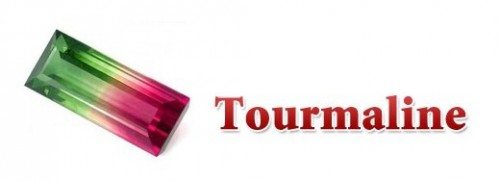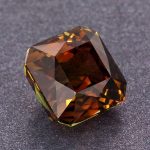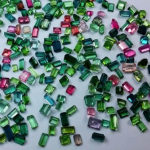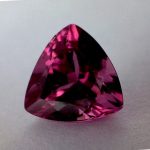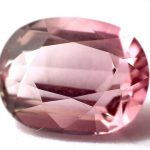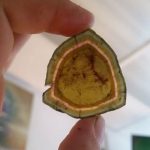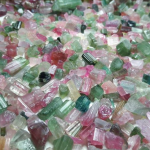Contents
Information
It is a complex borosilicate mineral that can show every color of the rainbow and occurs in more than 100 different color tonalities. Tourmaline is considered a very versatile gemstone, really appreciate by customers and jewelers, it is durable, attractive, available in all colors, abundant and with affordable price.
Tourmaline name derives from the word “turamali” that means “stone with many colors”, is a very ancient gemstone, discovered over five century ago, but only in 1875 Tourmaline was introduced by the gemologist George Kunz to the popular jeweler, Tiffany, that decreed in large scale its popularity.
It can be mined in many different colors so usually are called with specific name related to its natural color, like: Rubellite for the pinkish red variety which the color resembled Ruby, Watermelon for its multicolor variety that resemble the watermelon fruit, Polychrome Tourmaline when more than one color is present, Indicolite for the blue variety colored by an attractive indaco (indigo) blue color tone and more, or Elbaite Tourmaline used to indicate the bright green variety of Tourmaline and in general to describe the gemstone quality material.
It is usually affordable, large stone can be found easily like the black variety called Schorl Tourmaline, but not really appreciated like a gemstone, but also some green, pinkish, yellow can also be very cheap but attractive.
The most rare and precious variety of Tourmaline colored by copper that reveals the neon blue or bluish green variety called Paraiba Tourmaline (its name derives from the origin country where it was mined first, Paraiba state in Brazil) other valuable variety are Rubellite, chrome green Elbaite Tourmaline (originally discovered from Elba’s island in Italy), Indicolite Tourmaline.
This kind of gemstone has some interesting optical effect like pleochroism that means it can reveal different colors if watched from different angles.
Other popular variety of this material are: Dravite, Liddicoatite, Cuprian Tourmaline when the crystal is colored by copper.
Click here to buy online natural Tourmaline gemstones
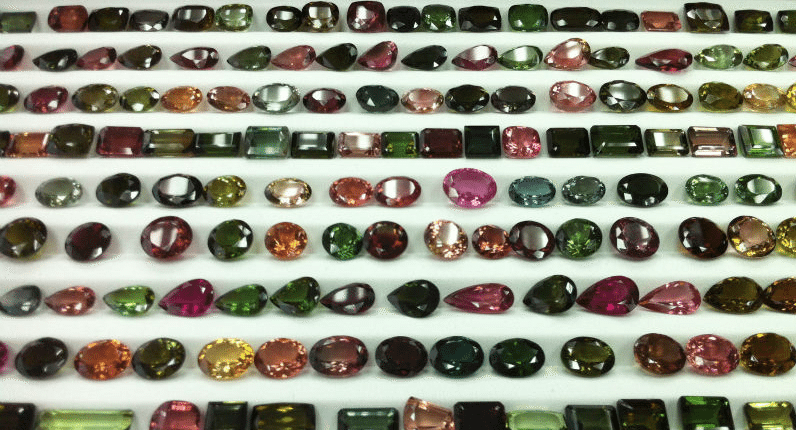
Tourmaline Healing Properties
Considered a strong detoxication stone, it is associated with the base chakra is considered a good talisman against to the anxiety, fear, digestive system, metabolism, encourage love, improve sexuality, pleasure, enthusiasm, keep balanced the body energy, brings positive energy and protection from negativity.
Treatment
They often comes out of the ground in transparent form, with good clarity, without visible inclusions and attractive colors so usually Tourmaline is sold untreated without any treatment to improve the color or clarity, but sometimes some color varieties like : yellow, pink and red are treated by irradiation or heat to improve their color deepness and enhance the color.
Sometimes the most rare and valuable gem varieties can be treated to improve clarity and appearance.
Irradiation is almost impossible to detect, is stable and it will not affect the value of the gemstone.
Origin and gemstone source
Tourmaline is the national stone of the United States (mined in Maine and California) where it is very popular and loved, can be mined in abundance, but the most exporter of this stones is Brazil, especially for gemstone quality of the rarest and most valuable varieties.
Sources for this material are also Africa (Madagascar, Mozambique, Malawi, Namibia, Tanzania, Nigeria, Zaire, Zambia, Zimbabwe) where can be mined, Bruma (Myanmar), Afghanistan, Pakistan, Nepal, Russia, Australia, Italy, Sri Lanka, Switzerland.
Click here to buy online natural Tourmaline gemstones
Optical Effect
It can present some interesting optical effect like chatoyancy, there are found a nice amount of good Cat’s Eye Tourmaline in different colors especially green, yellow, red and pink.
In some rare case it can show a color change in the blue Elbaite variety (named Laurellite) that switch color to a purplish violet color under incandescent light.
Images and Photos
Click here to buy online natural Tourmaline gemstones
Uses
Really appreciated by collectors Tourmaline gemstone is also loved in its natural mineral form with nice crystals plenty of colors available, is often mined in eye clean clarity and faceted into beautiful gemstone that can occurs in large size and offered at affordable prices.
Gemstones that present visible inclusions are usually cut into cabochon, carved into sculptures, or used to realized chips, briolette, rondelles and more.
Watermelon and Liddicoatite Tourmalines are usually cut into slices and sold on the gem market.
It is a durable gemstone with a hardness of 7-7.5 on the Mohs minerald hardness scale, can be largely used in jewelry without problems, can be set into bracelets, rings, pendants, earrings, necklace without particular issues.
Care and Cleaning
This is a durable stone but like any other gemstone, it deserve some care especially if worn every day and when you decide to clean it, you must avoid aggressive products like acids or chemicals, instead use only soapy water and soft cloth to clean the stone.
Remember to store your gemstone separately from other stone, because topaz, sapphire, ruby and diamond can easily scratch and ruins your stone.
Scam and Fraud
At the moment seems no synthetics gems are available on the market, but Tourmaline occurs in all the colors of the rainbow, so it can be easily confused with other similar natural gemstones.
- Emerald, Tsavorite and Demantoid garnet, green Apatite, Peridot can be easily confused with the green variety of Tourmaline.
- Aquamarine, Topaz, Sapphire, Blue Zircon can easily confused with Tourmaline.
- Ruby, Spinel, Rhodolite and other red garnet can be confused with Tourmaline.
- Kunzite, Spinel, Topaz, Morganite or pink Sapphire can be confused with Tourmaline.
- Neon blue Apatite can easily confused with the rare and valuable Paraiba Tourmaline.
Some unscrupulous seller can also sell colored glass or plastic gemstone for Tourmaline.
Typical Internal Inclusions
Observing Tourmalines at microscope you can spot some distinctive type of inclusions, like:
- Small threads like twist
- Liquid veils
- Hollow tubes
- Two and three phase inclusions
- Flattened liquid channels running parallels to the optic axis
- Negative Crystals
- Grown tubes
Gemological Info
- Mineral family: Tourmaline (complex borosilicate)
- Crystal: Trigonal
- Density: 2.9 – 3.3
- Hardness: 7 – 7.5
- Refractive index: 1.616 – 1.650
- Optic Character: Uniaxial
- Color: All (black, yellow, orange, green, blue, red, pink, brown, multicolor)
- Cause of color: Variable (copper in Paraiba)
- Luster: Vitreous
- Clarity: Type 1 (often eye clean) to type 3
- Fluorescent: Inert or weak
- Fracture: Conchoidal
- Cleavage: Indistinctive
- Durability: High
Click here to buy online natural Tourmaline gemstones

